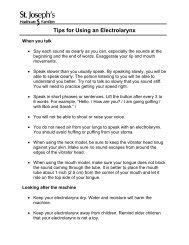Peripheral Thrombolysis - St. Joseph's Healthcare Hamilton
Peripheral Thrombolysis - St. Joseph's Healthcare Hamilton
Peripheral Thrombolysis - St. Joseph's Healthcare Hamilton
You also want an ePaper? Increase the reach of your titles
YUMPU automatically turns print PDFs into web optimized ePapers that Google loves.
4<br />
<strong>Peripheral</strong> <strong>Thrombolysis</strong><br />
Where will the tube be removed?<br />
• The tube will be removed in the nursing unit by the doctor or nurse.<br />
• Pressure will be applied to the puncture site.<br />
• A dressing will then be put on the site.<br />
• You will keep your leg or arm straight and lie flat for 6 to 8 hours.<br />
This promotes healing.<br />
• The nurses will check your blood pressure, pulses and the skin<br />
around the insertion site.<br />
Call your nurse right away if you have any of<br />
these signs:<br />
• bright red blood on the dressing<br />
• a change in the colour or feeling in your arm or leg<br />
• discomfort in your arm, leg or back<br />
• a headache<br />
What happens next?<br />
Other treatments and follow-up appointments will be discussed with you<br />
before you go home.<br />
When will I go home?<br />
Ask you doctor when you can go home.<br />
Arrange to have someone pick you up at 9:00 a.m. the day you leave<br />
the hospital.<br />
© <strong>Hamilton</strong> Health Sciences and<br />
<strong>St</strong>. Joseph’s <strong>Healthcare</strong>, <strong>Hamilton</strong><br />
PD 4450 - 03/2004<br />
dt/March 10, 2004<br />
WPC\PtEduc\LA<strong>Peripheral</strong><strong>Thrombolysis</strong>-trh.doc














